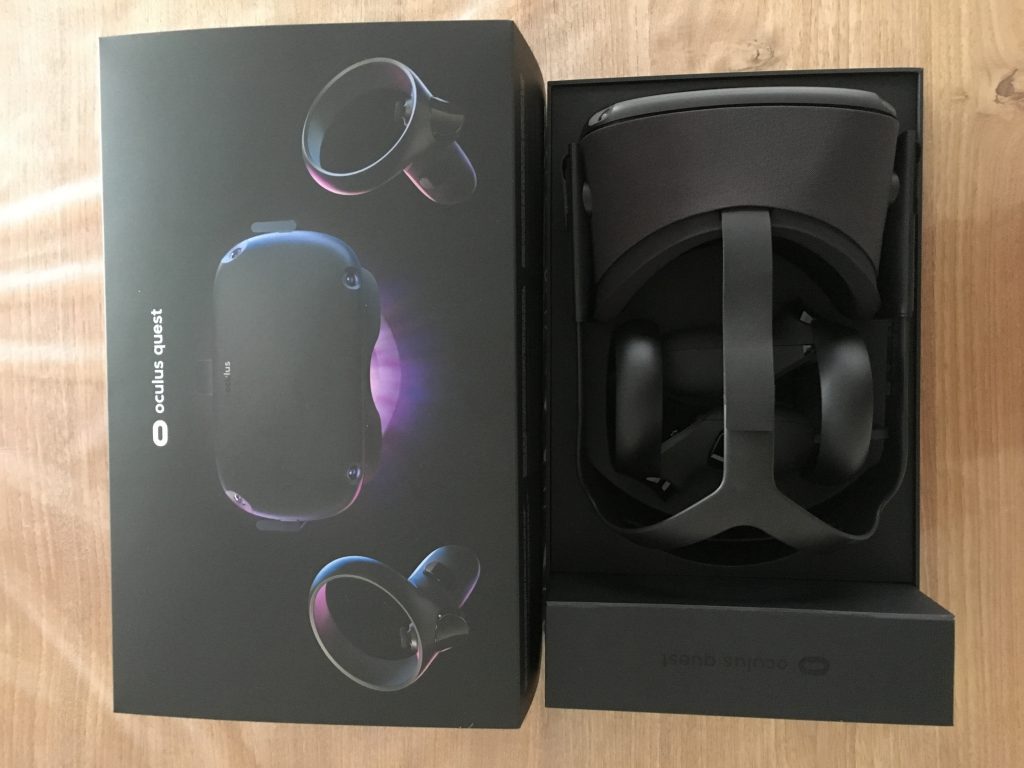This is by far the best Christmas I’ve ever had. And it’s even only May! But… it’s also the release date of the #OculusQuest and I got mine today. Of course I tested it immediately and I have to say: it was worth waiting for it. For the ones who are still wondering wether to buy or not, I wrote a first review.
Delivery:
The Quest is being delivered in a solid pitch black box, as was the Rift. The box itself is organised in such a way that I even think about using it as a travelcase! It really is solid, with some protection in it, which should absorb most bumps.
Delivery was carried out as promised: 21st of May.
What’s inside:
– The Quest headset;
– Two controllers with lanyards to prevent letting them falling onto the ground;
– Two alkaline batteries for the controllers (more about the batteries further);
– Charging adapter;
– USB-C cable;
– Spacer for people wearing glasses.

Setup:
Setting up the Quest is easier than ever. Just download the Oculus app (iOS or Android) and follow the steps. You might need to create an Oculus-account if you haven’t got one already.
A huge difference with the Rift before is setting your ‘guardian’ (= the limit of your play area). With the cameras you just see through your Quest and set up the guardian very easily and accurately.
After the setup you’re urged to some tutorial. They made it now more fun, using two basic games by which you come to understand your gear better.
Home Screen:
The home screen is the familiar home screen as ever before, no changes there. But it was intuitively before, so why change it?

Library:
The library is still somewhat limited, but of course it is only day one, so a lot more to come! There was a promise of cross-buy (= apps you already bought for e.g. the Rift, could also be played on the Quest), but the items in my library (e.g. Beat Saber, Tilt Brush…) do not support cross-buy, which means you have to pay for them again. Be mindful that all the items you bought in Steam do not support cross-buy for the Quest.
The Oculus app on your phone however is very handy to scroll through different experiences and buy them. You can easily change between Rift (S), Quest or Go.
Review of first gameplay experience:
I played nearly an hour non-stop with a fully charged headset and two fully charged batteries for the controllers.
I played three games: Beat Saber, Vader Immortal and Tilt Brush.
Tracking:
Tracking was very accurate. At no point tracking was lost, both during daylight and the dark. This often was the case with the Rift and Vive. Do not forget the fuss about setting up the sensors/lighthouses. Very glad to see the inside-out tracking cameras work perfectly fine.
Playing and wandering freely in VR without any cables adds to the ease of use greatly. This was one of the key assets of the Quest and it fully delivers.
Comfort:
The headset is firmly built, almost a copy of the Rift with the cotton cover, unlike the heavy plastics of the Vive for example. It looks fancy in that way too.
The Quest really feels comfortable: the padding for your forehead feels nice, even after one hour of non-stop playing. The weight is more or less the same as the Rift, but definitely less than the Go, which is nice.
The headstraps can be adjusted very easily and at the bottom of the headset is a switch to adjust the lenses for a clear view.
Under your nose still is some light leakage, which is a typical problem for VR-headsets. However, I find it rather handy still seeing a bit of the surrounding without having to take off your headset, but indeed it is somewhat a downplay of the immersion.
Graphics:
The graphics have met the expectations, perhaps even more: everything was clear and detailed (as far as it was intended to be). Yes, the blocks in Beat Saber were more detailed using Vive, but it did not have a negative effect on the gameplay or the feeling of presence. Tilt Brush, in which graphics make up the experience themselves, provides high quality pieces of art, even when you walk through them.

Sound:
The sound is clear and has a spatial aura. I tested it both with and without headphones. Without the headphones the sound already had enough depth to contribute to the overall experience. However, using my gaming headphones (Steelseries, circumaural) enhanced the experience, especially because you don’t hear any sounds from you surroundings.
Ease of use of controllers:
The controllers are easy to use, but when you’re used to playing with the Rift, you will continuously hold them the upside-down (at least I did…): the circle holding the sensors on the Quest is turned upwards, while with the Rift this was downwards.
They are lightweight and are built ergonomically (typically Oculus, which I believe is a huge plus over the Vive). They are a bit smaller than the Rift controllers which makes them feel a bit vulnerable the first time, but after some minutes of playing, you even forget they are in your hands; they are your hands.
Duration of battery:
After playing one hour non-stop, the battery dropped to a 58% level. So the promise of 2,5 hours of gameplay is rather accurate. You can always add extra juice by connecting it to a battery charger, but then you’re wired again…
The battery level of the controllers was still fully 100%.
A detail, but rather handy: in the home screen, you can see all the battery levels.
The extras (or not?):
When you want to share your gameplay with other people (for example family in the living room) through casting, you will be rather disappointed (as I am and many others are, judging from the VR-groups on Facebook). Casting is possible theoretically: you can cast your gameplay from the headset to your phone (just activate in the app) and cast it to a Chromecast. Casting to Apple TV is not supported natively, but of course you can cast your phone to Apple TV using Airplay (however, it fails often from my experience). Theoretically… Some apps do not support casting (or even making a picture or video of your gameplay), such as Beat Saber or Vader Immortal. Especially these games are the games everyone likes to cast, so this is a major disappointment to many. Rumours say it will be supported in a later update, we’ll have to see… Tilt Brush allows for casting to Chromecast and works perfect.

Sharing pictures or videos is supported only via Facebook. Again this is somewhat disappointing. There is a way around: I just shared my pictures on Facebook privately and then downloaded them. Not exactly user friendly, but hey, it works.
Conclusion
The VR-fans had to wait rather long for this Quest, especially with a rather vague release date of ‘Early Spring’, which in the end turned out to be the 21st of May. But… it truely will be the widespread breakthrough of VR: the price, the comfort of wireless gaming, the ease of use, the performance… all those make up for a great VR-headset which will be used in a lot of different settings, such as gaming, entertainment, training…
As mashable called it “VR’s knight in shining armor”, the world of VR was praised with this great gift and the future only shines brighter!

